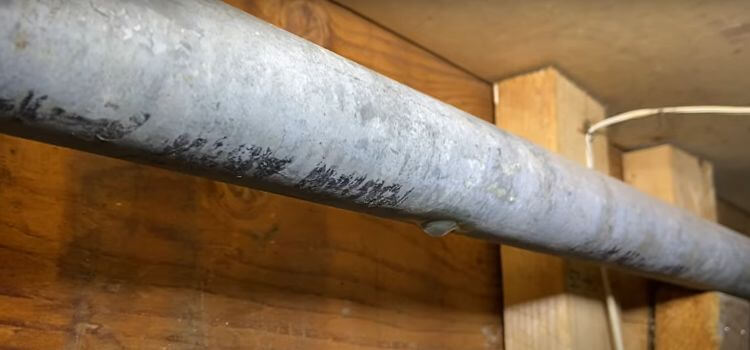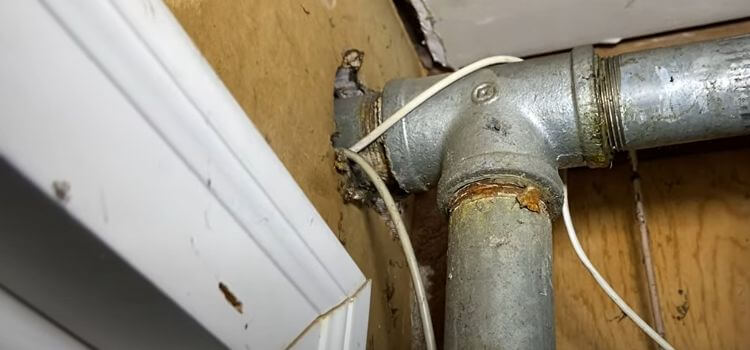To connect galvanized pipes without threads, use a pipe coupling. This method involves clamping the pipes together securely.
Galvanized pipes are commonly used for their corrosion resistance and durability. Connecting these pipes without threads can be necessary in certain plumbing or construction scenarios. A pipe coupling offers a reliable solution by enabling a secure, leak-proof connection. This method is particularly useful in situations where threading is not feasible or when repairing existing pipelines.
Pipe couplings come in various sizes and materials, making them versatile for different applications. By using a coupling, you ensure that the integrity of the galvanized pipes remains intact while achieving a seamless connection. This technique simplifies the process and maintains the functionality of your piping system.

Materials Needed
Connecting galvanized pipes without threads can seem tricky, but with the right materials and tools, it becomes much easier. This guide will show you what you need and how to do it step by step.
Types Of Pipe
There are different types of pipes you can use. Galvanized pipes are coated with a layer of zinc. This helps them resist rust and corrosion. Here are some common types:
- Standard Galvanized Pipe: Used for water supply lines.
- Galvanized Steel Pipe: Stronger and used in larger projects.
- Flexible Galvanized Pipe: Easier to bend and install in tight spaces.
Each type has its own pros and cons. Standard pipes are great for home use. Steel pipes are better for industrial jobs. Flexible pipes are perfect for tricky installations. Choose the type that fits your project needs.
Tools Required
Connecting pipes without threads needs special tools. These tools help you make strong and leak-proof connections. Here is a list of what you will need:
- Pipe Cutter: To cut the pipe to the required length.
- Pipe Fittings: Connects pipes together securely.
- Pipe Wrench: Tightens the fittings.
- Pipe Sealant: Prevents leaks at the joints.
- Measuring Tape: Ensures accurate pipe lengths.
- Safety Gear: Protects your hands and eyes.
Using the right tools makes the job easier. A pipe cutter gives a clean cut. Pipe fittings and a wrench ensure a tight connection. Sealant stops any water from leaking. Always measure twice before cutting.
Read Also: Will Sharkbite Work on Galvanized Pipe
Choosing The Right Fittings
Connecting galvanized pipes without threads can be tricky. Choosing the right fittings is crucial. These fittings ensure a secure and leak-free connection. There are various types of fittings available. Compression and push-fit fittings are popular choices. This guide will help you understand each type.
Compression Fittings
Compression fittings are a popular choice for connecting galvanized pipes without threads. These fittings use a compression nut and a ferrule to create a tight seal. Here are some key points:
- Compression fittings are easy to install.
- They do not require any special tools.
- These fittings provide a strong and reliable connection.
Installation Steps:
- Cut the pipe to the desired length.
- Place the compression nut on the pipe.
- Slide the ferrule onto the pipe.
- Insert the pipe into the fitting.
- Tighten the compression nut by hand.
- Use a wrench to secure the connection.
Advantages of Compression Fittings:AdvantageDescriptionEase of InstallationAnyone can install these fittings without special skills.Cost-EffectiveThese fittings are affordable and widely available.Reliable SealThey provide a leak-free connection under pressure.
Push-fit Fittings
Push-fit fittings offer a quick and easy solution. These fittings are simple to use and require no tools. Here are some key points:
- Push-fit fittings are user-friendly.
- They are suitable for DIY projects.
- These fittings create a strong connection quickly.
Installation Steps:
- Cut the pipe to the required length.
- Ensure the pipe ends are clean and smooth.
- Insert the pipe into the fitting.
- Push the pipe until it clicks into place.
- Check the connection for security.
Advantages of Push-Fit Fittings:AdvantageDescriptionEase of UseThese fittings can be installed without any tools.Quick InstallationThey save time and effort during installation.FlexibilityPush-fit fittings can be used with various pipe materials.
Preparing The Pipe
Connecting galvanized pipes without threads can be tricky. Many people think it is impossible. But you can do it with the right tools and techniques. Preparation is key. In this guide, we will explain how to prepare the pipe. You will learn how to cut and clean the edges. Follow these steps to ensure a secure connection.
Cutting The Pipe
First, measure the length of the pipe you need. Use a tape measure. Mark the spot where you want to cut. Make sure the mark is clear. You can use a marker or a piece of chalk.
Choose a pipe cutter or a hacksaw. A pipe cutter is easier to use. It gives a clean cut. Place the cutter on the mark. Tighten the cutter around the pipe. Rotate the cutter around the pipe. Tighten it a little more after each turn. Keep rotating and tightening until the pipe is cut through.
If you use a hacksaw, secure the pipe in a vise. This will keep it steady. Saw back and forth on the mark. Make sure your strokes are even. Check your cut to ensure it is straight. A straight cut is important for a good connection.
Cleaning The Edges
After cutting the pipe, you need to clean the edges. This will remove any burrs or rough spots. These can interfere with the connection. Use a metal file to smooth the edges. File in one direction. Check the edge frequently. Make sure it is smooth.
Next, use sandpaper to clean the inside and outside edges. This will help remove any small metal bits. It also makes the surface smoother. A smooth surface ensures a better seal.
Finally, wipe the edges with a clean cloth. This removes any dust or debris. Your pipe is now ready for the next step. A clean edge is crucial for a secure and leak-free connection.
Using Compression Fittings
Connecting galvanized pipes without threads can be tricky. One simple method involves using compression fittings. These fittings create a tight seal without the need for threading. This guide will explain how to use them effectively.
Installation Steps
Using compression fittings is straightforward. Follow these steps to connect your galvanized pipes:
- First, cut the pipe to the desired length.
- Next, clean the pipe ends to remove any debris.
- Then, slide the compression nut onto the pipe.
- After that, place the compression ring on the pipe end.
- Insert the pipe into the compression fitting body.
- Tighten the compression nut using a wrench.
- Check the connection for any leaks.
Make sure to apply even pressure when tightening the nut. This ensures a secure connection. If the connection leaks, tighten the nut a bit more.
Sealing Techniques
Proper sealing is crucial for preventing leaks. Here are some effective techniques:
- Use pipe dope or thread sealant on the compression ring.
- Apply Teflon tape to the pipe threads if using threaded parts.
- Ensure the compression ring is seated properly before tightening.
Pipe dope helps create a waterproof seal. Teflon tape is useful for threaded connections. Make sure all parts are clean before sealing.
Finally, always test the connection after installation. Run water through the pipe and check for leaks. Tighten any loose fittings as needed.
Using Push-fit Fittings
Connecting galvanized pipes without threads can seem hard. Using push-fit fittings makes this job easier. These fittings provide a fast and secure connection. No threading, soldering, or gluing is needed. This method suits both DIYers and professionals. It is perfect for quick repairs and pipe installations.
Installation Guide
To connect pipes with push-fit fittings, follow these steps:
- Cut the pipe: Use a pipe cutter to get a clean, straight cut.
- Deburr the pipe: Remove sharp edges with a deburring tool.
- Mark the insertion depth: Use a marker to indicate how far the pipe should go into the fitting.
- Insert the pipe into the fitting: Push the pipe firmly until it reaches the mark.
Check the connection. Make sure the pipe is secure. Turn on the water supply. Look for any leaks. If there are leaks, remove and re-insert the pipe.
Push-fit fittings are easy to use. They work well with different pipe materials. No special tools are needed. Just ensure the pipes are clean and smooth.
Advantages And Disadvantages
Push-fit fittings have several advantages:
- Easy to install: No need for special tools.
- Time-saving: Quicker than traditional methods.
- Versatile: Works with various pipe materials.
- Reusable: Can be removed and reused easily.
They also come with some disadvantages:
- Cost: More expensive than traditional fittings.
- Durability: Not as durable as threaded connections.
- Limited sizes: Available in fewer sizes compared to other fittings.
Understanding the pros and cons helps in making the right choice. Push-fit fittings are great for quick fixes. For long-term solutions, assess the need carefully.
Testing For Leaks
Connecting galvanized pipe without threads can be tricky. Testing for leaks is vital. This ensures the connection is secure. It also prevents future problems. Here’s how to do it right.
Pressure Testing
Pressure testing checks if your pipe is sealed tight. It helps you find leaks quickly. Start by closing all valves. Attach a pressure gauge to the pipe. Use a pump to add air or water. Watch the gauge carefully.
Here are the steps for pressure testing:
- Close all valves to isolate the pipe.
- Attach a pressure gauge to the open end.
- Use a pump to add air or water slowly.
- Check the gauge for any drops in pressure.
If the gauge shows a drop, there is a leak. Look for bubbles if using water. Listen for hissing sounds if using air. A stable gauge means no leaks. Testing helps ensure your connection is leak-proof.
Visual Inspections
Visual inspections are also crucial. They help spot leaks your gauge might miss. Look at the pipe closely. Check all joints and connections. Any wet spots or rust can signal a problem.
Here are the steps for visual inspections:
- Inspect all joints and connections closely.
- Look for wet spots around the pipe.
- Check for rust or corrosion.
- Use a flashlight to see better in dark areas.
Visual checks work well with pressure tests. Together, they give the best results. Always double-check to ensure safety. Spotting a leak early can save lots of trouble later.
Common Mistakes
Connecting galvanized pipe without threads can be tricky. Many people make mistakes that lead to leaks or weak joints. In this guide, we’ll discuss common mistakes and how to avoid them. Proper techniques will ensure a secure and lasting connection.
Improper Cutting
One common mistake is improper cutting of the pipe. If the cut is not straight, the connection won’t be secure. This can lead to leaks and other issues. Here are some tips to avoid improper cutting:
- Use a pipe cutter instead of a hacksaw for a cleaner cut.
- Ensure the pipe is clamped securely before cutting.
- Measure twice before making any cuts to ensure accuracy.
Another issue is not deburring the pipe after cutting. Burrs can prevent a tight seal and cause leaks. Use a deburring tool to clean the edges. This will help create a smooth surface for a better fit.
Incorrect Fitting Use
Using the wrong type of fittings can also cause problems. Compression fittings are a good choice for connecting galvanized pipes without threads. They offer a strong, leak-proof connection when used correctly. Follow these tips for proper fitting use:
- Choose fittings that are compatible with galvanized pipes.
- Ensure the fittings are clean and free of debris before installation.
- Tighten the fittings according to the manufacturer’s instructions.
Another mistake is over-tightening the fittings. This can damage the pipe and the fitting. Always follow the recommended torque specifications. Over-tightening can cause the fitting to crack or the pipe to deform.
Maintenance Tips
Connecting galvanized pipe without threads might seem tricky, but it’s quite simple with the right tools and techniques. Galvanized pipes are known for their durability and resistance to rust, making them a popular choice for plumbing and construction. Proper maintenance of these pipes ensures they last even longer. This guide will provide valuable tips on how to connect these pipes and maintain them effectively.
Regular Inspections
Regular inspections are crucial to ensure the longevity of galvanized pipes. Inspect your pipes every six months to check for signs of wear and tear. Look out for rust spots, leaks, and loose connections. These are common issues that can be fixed early to prevent bigger problems. Use a flashlight to examine hard-to-reach areas.
Here are some steps to follow during inspections:
- Check for rust or corrosion on the surface of the pipes.
- Look for leaks around the connections and joints.
- Ensure connections are tight and secure.
- Examine the surrounding area for water damage or dampness.
It’s also helpful to keep a record of your inspections. Note any issues found and the repairs made. This helps track the condition of your pipes over time. If you find any serious damage, contact a professional plumber for repairs.
Cleaning Recommendations
Regular cleaning of galvanized pipes prevents buildup and maintains water flow. Use a wire brush to remove any loose rust and debris from the surface. For deeper cleaning, a solution of vinegar and water works well. Soak a cloth in the solution and wrap it around the pipe, letting it sit for a few hours.
Steps for effective cleaning:
- Use a wire brush to scrub the pipe’s surface.
- Prepare a vinegar and water solution in a 1:1 ratio.
- Soak a cloth in the solution and wrap it around the pipe.
- Let it sit for a few hours to break down rust and debris.
- Rinse with clean water and dry the pipe thoroughly.
For stubborn rust, consider using a commercial rust remover. Always wear gloves and protective eyewear when handling cleaning solutions. Regular cleaning keeps your galvanized pipes in excellent condition and extends their lifespan.
Frequently Asked Questions
Is There A Sharkbite For Galvanized Pipe?
No, SharkBite fittings are not designed for galvanized pipes. Use a threaded transition fitting for galvanized connections.
Do Compression Fittings Work On Galvanized Pipe?
Compression fittings can work on galvanized pipe. Ensure the pipe is clean and smooth for a proper seal. Use the right tools to avoid leaks.
Can I Use A Pvc Compression Coupling On Galvanized Pipe?
Yes, you can use a PVC compression coupling on galvanized pipe. Ensure the pipe size matches for a secure fit.
Can You Use A Pipe Threader On Galvanized Pipe?
Yes, you can use a pipe threader on galvanized pipe. It is essential to use cutting oil to prevent damage.
Conclusion
Connecting galvanized pipes without threads is straightforward with the right tools and techniques. Always ensure your fittings are secure and leak-free. This method saves time and effort, making your plumbing tasks easier. Follow these steps for a reliable connection every time.

